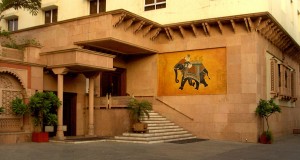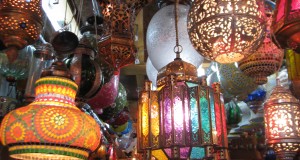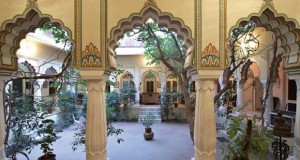Review Overview
3
Summary : A charming oasis on the very edge of the desert, Pushkar is the perfect place to wind up one's tour of Rajasthan.
A charming oasis on the very edge of the desert, Pushkar is the perfect place to wind up one’s tour of Rajasthan. It is a tiny pilgrim town, fronting a holy lake, separated from nearby Ajmer by the ‘Snake Mountain’ of Nag Pahar.
Pushkar has one of the few Brahma temples in India. The legend is that a lotus fell from the hand of Brahma while he was searching for a place to perform yagna (sacrifice), and a lake sprang up. Brahma decided to make his home here, and a temple was built in commemoration. For ages past, Hindu pilgrims have flocked to Pushkar. Rama, hero of the Hindu epic Raniayana (1500 BC) is said to have paid his respects here, and the journals of Fa Hsien, the 4th-century AD Chinese tr aveller confirm it as a major pilgrimage centre. The palaces and temples around the hie were a later addition of the Rajput maharajahs. Man Mahal, the palace built by rajah Mansingh I of Amber, stands on the bank of the lake, and has been converted Tinto the present Tourist Bungalow. Today, there are over 400 temples in Pushkar, And 90% of the population are said to belong to the community of priests.
Nor much of the year, Pushkar is a peaceful place with the emphasis on relaxation. Travellers come here for a total break from the rest of India. But at the annual Cattle and Camel Fair each November, it’s a different story entirely: up to 200 000 traders and 50 000 cattle pour into town, along with numerous tetooned camels and colourful pilgrims. After 10 hectic days of livestock-dealing, camel-racing, and colourful festivities, everybody goes for a big holy dip in Ow lake on the night of the full moon ( Kartik Purnima). An explosion of fun, ludic, games and laughter’, the fair provides some wonderful photographic opportunities . Also a rare occasion to see the Rajasthani women decked out in all their traditional jewellery, dress and finery. If this sounds your idea of fun, go for the last 5 days of the festival, and contact the Rajasthan Tourist Office, which organises traditional dance programmes, cultural events and cented accommodation. The next fairs will be 26-29 November 1993, 15-18 November 1994 and 6-8 November 1995.
WHAT TO SEE fightseeing is probably the last thing on your mind when you come here. Pushkar on a tiny, sleepy desert town which instantly envelops visitors in a calm embrace of inertia. The little activity there is—shops, restaurants, markets—centres on the single long street which tracks round the northern end of the lake, parallel to the bathing ghats. There are no taxis or rickshaws, nor any need for them. Cycles can be hired at Rs10/day from the rank near Pushkar Hotel, but most people prefer to walk. There’s a regular parade of travellers trooping up and down the high s treet-trying on hippy clothes, buying silver bangles, drinking endless lassis, doing puja at the ghats, or simply collecting strange signs. A few examples are: ‘Donate for Cow Saint and Words’ (a temple), ‘Welcome to see the real Mac Coy—Men at Work’ (a handicrafts shop), and ‘Surprising how a Single Name can l unge your Outlook’ (a cigarette advertisement).
Spend your first day or two simply winding down—sunbathing, shopping, swimming and making new friends. Then, when you’re up to some activity, try the lollowing early morning jaunt.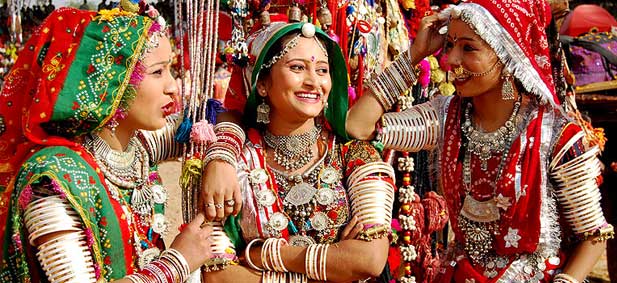
Desert/Town Tour (on foot, 3/4 hours) Savitri Temple-Brahma Temple-Bathing Ghats -Old Pushkar Set out early (8 am latest, to avoid the heat) down at the lakeside, below the lourist Bungalow. While crossing the narrow causeway to the peaceful southern ghats, look out for holy turtles (sacred to Brahma) swimming below. On the far Bank, visit the marshy wetlands behind the thin forest—it’s a birdwatcher’s paradise. Back at the bridge, walk along the ghats by the lakeside until (quite unexpectedly) you emerge at the edge of the desert. Up ahead, atop a high peaked hill, is the small white Savitri Temple, dedicated to Brahma’s first wife. The legend goes that after Brahma dropped his lotus flower at Pushkar, he returned to do yagna (purification ritual) here. Unfortunately, he didn’t wait for his wife Sav itri to show up. Instead, he took a substitute bride called Gayatri to help him officiate at the ceremony. Gayatri (who has a temple of her own, above Marwar bus-stand) was an untouchable, and to make her holy, she was apparently ‘put into the mouth of a cow and removed from the anus’.
Drastic, but apparently effective. When Savitri finally put in an appearance, she was not amused. She began cursing people. First she cursed Vishnu with everlasting estrangement from his wife. Then she coursed Shiva with eternal unhappiness. Then she cursed the Brahmins with never-end ing poverty. She even cursed Gayatri’s cow. Then, having cursed everyone who nail approved the marriage, she turned on Brahma himself, saying, ‘Take Pusher. But it’s going to be the only home you ever have!’ With this, she stormed off up to the hill, and has been sulking there ever since. Brahma tried to cheer her up with the present temple, but she’s still upset.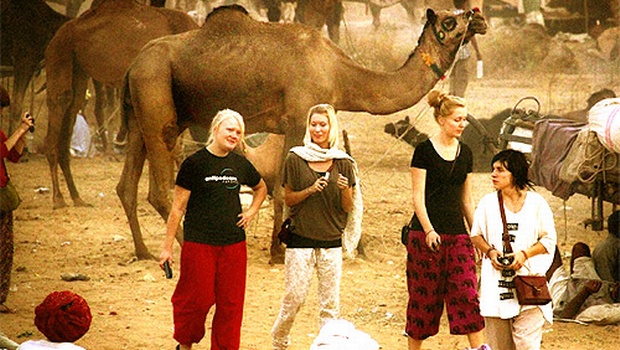
Going up to see her involves a marvelous 20-minute stroll across the rolling dunes-a real compensation if you didn’t see any at Jaisalmer—followed by a half-hour hike up an ancient, crumbling stone stairway (built around the 4th century AD), with the views getting better the higher you go. The temple itself dates back some 2000 years, and is a small, well-kept affair. If you make it to the top, you’ll probably be rewarded with a cup of refreshing mint tea. Get your breath back, then get out your camera—the views down over Push kar and its lakes are spectacular, while to the rear the white, undulating sands stretch back for as far as the eye can see.
Walking back across the dunes, re-enter Pusher to the west for the pink-dot wed Brahma Temple. This is a bright, Disneyish effort—a riot of blue, green, ye] ow and red paint. It is immaculately clean, has great atmosphere, and sits with n a small enclosure backing directly on to the desert. Over the entrance gatesway , you’ll find the hans or goose symbol of Brahma, while below it (facing into the shrine) there is his ‘carrier’, a silver turtle. This is inset into the marble floor , together with neat serried rows of old silver coins. Walk to the rear of the temple , through the small chamber with ‘Donate to Cows’ moneybox, for pict y repostcard views of the desert.
The main road leading back into town runs alongside a succession of road ide temples (mainly to the left) and lakeside ghats (the northern series, all to right). (ou can visit any of these ghats, where you’ll be expected to do Brahma Puja. This is a devotional exercise which commences with the giving of flowers, fruit, rice and coconut, and is expected to end with the giving of money.
Pushkar town is actually larger than may at first appear. Walking north of the touristy main street takes you into an extensive maze of charming old houses, sleepy backstreet temples, often guarded by aggressive monkeys, smart pilgrims’ dhar ymsalas and shady banyan trees parked with dozy dogs, camels and cows.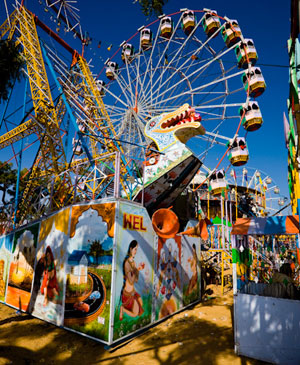
Return to the Tourist Bungalow for a swim in the lake. The water is fairly can and, since the removal of the resident crocodile, who ate a visiting official, very side. The small island in the lake centre is Guru Ghat—a popular target for bathers, since you can stand on it.
For better swimming, you’ll want to take a camel/jeep excursion out to Old Pus kar lake, 5 km (3 miles) north across the desert. But first you’ll need to know a little more mythology—because there is not just one Pushkar, but three! When Brahma let fa the lotus blossom (push pa) from his hand (kar)—giving rise to Pushkar-it fell at three sep ate places, like the Barnes-Wallis bouncing-bomb. Senior Pushkar, where all the pilgrimsand tourists stay, is considered the most holy spot because the lotus fell here first. After that, it fell on Middle Pushkar, 2 km up the road, and then on Junior (Old) Pushkar, 3 km further north. Pilgrims visit all three spots. After that, they hop on buses bound for other holy venues like Badrinath and Hardware. A lot of elderly Hindus spend their waning years roaring from one holy lake to the next in ghastly video buses.
Ram’s Camel Adventures (motto: ‘Me enjoy people’) is located just up from the Pushkar Palace Hotel, and runs camel- and jeep-treks out to Old Pusher and other surrounding beauty spots, and they’re usually great fun. You can stop off at Middle Pushkar, which has a small Hanuman Temple, a 200-year-old banyan tree, and a natural ground-water well. Despite years of successive drought, this tank has not run dry. Middle Pusher is where the incurably insane come twice a year, at auspicious full moons to recover their minds. It is otherwise unremarkable. Old (junior) Pusher has a small Krishna temple, a charming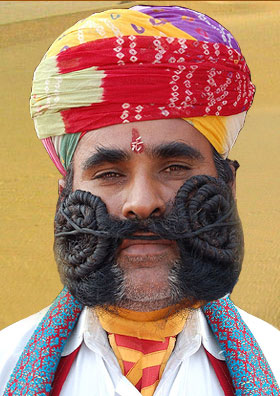 village (with very friendly people) and a large ex-lake. The ex-lake has been sadly reduced by successive droughts—and by the pipeline sunk here, which supplies water to Ajmer railway depot. It is now planted with sugar-cane, and you can for the time being forget all about swimming. The legend of Old Pusher is that Aurangzeb came here once, Intent on destroying more temples. After washing his face he saw his reflection, however, ‘his hair turned grey and he began to look like an old man’. This experience apparently cured Aurangzeb of iconoclasm for life.
village (with very friendly people) and a large ex-lake. The ex-lake has been sadly reduced by successive droughts—and by the pipeline sunk here, which supplies water to Ajmer railway depot. It is now planted with sugar-cane, and you can for the time being forget all about swimming. The legend of Old Pusher is that Aurangzeb came here once, Intent on destroying more temples. After washing his face he saw his reflection, however, ‘his hair turned grey and he began to look like an old man’. This experience apparently cured Aurangzeb of iconoclasm for life.
Pushkar (senior) is best at sunset when the dry heat is relieved by a cool breeze, the glare of the sun dies away, and the fading desert lights turn the lake a fiery bloodcrimson. As the time approaches for worship, the hundreds of little temples by the lakeside come to life, and the air is filled with the clanging of bells, the beating of drums and the hypnotic drone of prayer. For many, this is the most authentically ra’itupali erxipteruienacel of their entire Rajasthan tour.
SHOPPING Pusher is an excellent shopping venue. Unlike Jaipur or Jaisalmer where anyone who ‘shows you his shop’ gets 30% under the table, there’s usually no middleman here to stop you getting a sensible price. The most popular buys are cheap, colourful cottons clothes—either ready-made or made-to-measure by the town’s excellent tailors.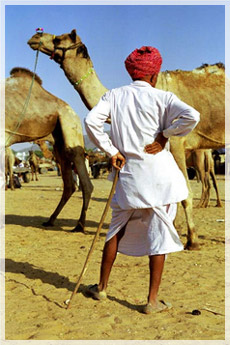
All Pusher’s shops are concentrated in the single main street running along by THe northern ghats: very convenient, and very difficult to resist. If you can run this colourful, inviting gauntlet without buying something (or anything), you’re either very strong-willed or very poor. Two particularly good places for Rajasthani embroidery and clothes are Swami Lilashah Cloth Store and Nathu Rain’s Chilum Shop, both near Gau Ghat. Clothes are very cheap (bright shirts, dresses, trousers and embroidered waistcoats), and mirror-embroidered items go for a song (wallhangings, large bags, cushion-covers). Most of this stuff is second-rate, so do check all seams. They’re often poorly finished.
Something not to buy in Pusher is silver. A lot of so-called pure silver is actually 60% copper, and will tarnish quickly. Be equally suspicious of ‘antique’ silver, which rarely more than a month old.
On a rather more mundane note, Pusher is also a good place to sell things. The market full of second-hand bookshops—every one of them obsessed with the idea of buying your camera, Walkman, or spare film. Selling you a book may not occur to them.
WHERE TO STAY
Mid-range (US$10-25/Rs250-750 per room night) Pushkar’s two reasonable hotels both have desert-palace architecture, overlook the lake, and are the first places you come to walking into town from bus-stand. RTDC’s Sarovar Tourist Bungalow started life some 500 years ago, the summer palace of the Maharajah of Jaipur. Today, it has a lovely garden terrace, a relaxing sun-roof, and a choice of cosy old-style rooms (from Rs11 and modern, characterless rooms with air-cooling. Meanwhile, the adjoining Pushkar Hotel (tel 1) goes from strength to strength. Another old palace, but for the Maharajah of Kishangarh, it has gone—in the space of a few years—fro dopehead den of iniquity to the smartest, most select place in Pushkar. Co mple ly renovated, it now boasts several deluxe suites, with modern tiled bathroom from Rs250, in addition to its many cheaper rooms. Again, you have a sun-room nice gardens, and ethnic decor throughout. But there’s also excellent food, r’ able service, and superb transport information. Owner Jagat Singh, and mana Mr Saxena take care of all rail/bus reservations and offer great camel-/jeep-treks out into the desert. Pushkar Palace has the best and most reasonably priced travel desk in town.
mple ly renovated, it now boasts several deluxe suites, with modern tiled bathroom from Rs250, in addition to its many cheaper rooms. Again, you have a sun-room nice gardens, and ethnic decor throughout. But there’s also excellent food, r’ able service, and superb transport information. Owner Jagat Singh, and mana Mr Saxena take care of all rail/bus reservations and offer great camel-/jeep-treks out into the desert. Pushkar Palace has the best and most reasonably priced travel desk in town.
An okay fallback is Peacock Holiday Resort (tel 18), located 200 yards back from the bus-stand, on the fringe of town, with a pleasant little swimming-pool and an unpleasant manager.
Budget (Under US$10/Rs250 per room night) There are many cheapies, most extremely basic. Current favourites include T Om,The Royal Guest House (very central), The Lakeview and The Shiva.
EATING OUT You’ll be glad to get back to Delhi. The food here is very plain and simple. This i: religious centre and vegetarianism is carried to an extreme. Meat, even eggs, are on obtainable on the black market. Pushkar Hotel’s buffet suppers are from 6 to 9 pm daly, and are excellent 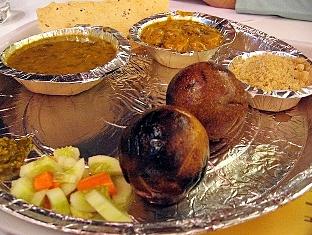 value. The nearby Sunset Cafe is popular with the young crowd, mainly for pancakes, omelettes, snacks, good music and lake view, but is dirty. A little further on, directly opposite the Brahma Temple, R.S. Restaurant is cosy with some dishes that are ‘very, very special’, but for the past years or so travellers have favoured the Om Siti va roof-top restaurant, especially for its cheap and varied buffet meals. Meals in Pushk ar are never expensive and range from Rs30 to 70.
value. The nearby Sunset Cafe is popular with the young crowd, mainly for pancakes, omelettes, snacks, good music and lake view, but is dirty. A little further on, directly opposite the Brahma Temple, R.S. Restaurant is cosy with some dishes that are ‘very, very special’, but for the past years or so travellers have favoured the Om Siti va roof-top restaurant, especially for its cheap and varied buffet meals. Meals in Pushk ar are never expensive and range from Rs30 to 70.
GENERAL INFORMATION The nearest tourist office, in Ajmer at Khadim Tourist Bungalow (tel 20490),hopeless. Much better information at Pushkar Hotel, courtesy of Surendra Singh. Main GPO (open 10 am to 5 pm except Sundays) is near the Marwar bus-stand at the far end of town, but most travellers use the small sub-post office in the Sadar Bazaar. It used to be the most unpredictable post office in India, with days when it would sell stamps and days when it wouldn’t. ‘We used to have a crazy postman who stamped letters or not according to his whim’, explained Mr Singh, ‘but now we have a postman who does his duty’.
State Bank of Bikaner & Jaipur, 5 minutes down the road from Pushkar Hotel, is the only place in town to change foreign currency legally.



